《电路》课程实验教学大纲 Experiment of Electric Circuit B
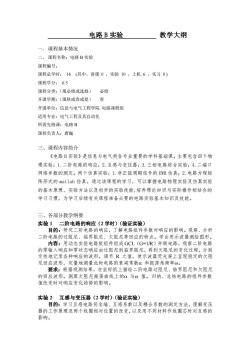
电路B实验 教学大纲 一、课程基本情况 二、课程名称:电路B实验 课程编号: 课程总学时:16(其中,讲课0,实验10,上机6,实习0) 课程学分:0.5 课程分类:(填必修或选修)必修 开课学期:(填秋或春或夏)春 开课单位:信息与电气工程学院电路课程组 适用专业:电气工程及其自动化 所需先修课:电路B 课程负责人:唐巍 三、课程内容简介 《电路B实验》是信息与电气类各专业重要的学科基础课。主要包含四个物 理实验:1.二阶电路的响应;2.互感与变压器:3.三相电路综合实验:4.二端口 网络参数的测定。两个仿真实验:1.非正弦周期信号的EB仿真:2.电路方程矩 阵形式的matlab仿真。通过该课程的学习,可以掌握电路物理实验及仿真实验 的基本原理、实验方法以及初步的实验技能,培养理论知识与实际操作相结合的 学习习惯,为学习后续有关课程准备必要的电路实验基本知识及技能。 三、各部分教学纲要 实验1二阶电路的响应(2学时)(验证实验) 目的:研究二阶电路的响应,了解电路组件参数对响应的影响。观察、分析 二阶电路的过阻尼、临界阻尼、欠阻尼等回应的特点。学会用示波器测绘图形。 内容:用动态实验电路板组件组成GCL(G=1R)并联电路,观察二阶电路 的零输入响应和零状态响应由过阻尼到临界阻尼,再到欠阻尼的变化过程,分别 定地录冬种应的波形。调节R之值 ,使示波器荧光屏上呈现稳定的欠图 尼回应波形, 定量地测量此时电 路的衰 常数a和振荡角频率o。 要求:根据观测结果,在坐标纸上描绘二阶电路过阻尼、临界阻尼和欠阻尼 的回应波形。测算欠阻尼振荡曲线上的α与o值。归纳、总结电路的组件参数 值改变时对响应查化趋势的影向。 实验2互感与变压器(2学时)(验证实验) 目的:学习互感电路同名端、互感系数以及耦合系数的测定方法,理解变压 修的作原理及两个线圈相时位置的政交,以及用不洞材料作我图时对互感
电路 B 实验 教学大纲 一、 课程基本情况 二、 课程名称:电路 B 实验 课程编号: 课程总学时: 16 (其中,讲课 0 ,实验 10 ,上机 6 ,实习 0 ) 课程学分: 0.5 课程分类:(填必修或选修) 必修 开课学期:(填秋或春或夏) 春 开课单位:信息与电气工程学院 电路课程组 适用专业:电气工程及其自动化 所需先修课:电路 B 课程负责人:唐巍 三、课程内容简介 《电路 B 实验》是信息与电气类各专业重要的学科基础课。主要包含四个物 理实验:1.二阶电路的响应;2.互感与变压器;3.三相电路综合实验;4.二端口 网络参数的测定。两个仿真实验:1.非正弦周期信号的 EWB 仿真;2.电路方程矩 阵形式的 matlab 仿真。通过该课程的学习,可以掌握电路物理实验及仿真实验 的基本原理、实验方法以及初步的实验技能,培养理论知识与实际操作相结合的 学习习惯,为学习后续有关课程准备必要的电路实验基本知识及技能。 三、各部分教学纲要 实验 1 二阶电路的响应(2 学时)(验证实验) 目的:研究二阶电路的响应,了解电路组件参数对响应的影响。观察、分析 二阶电路的过阻尼、临界阻尼、欠阻尼等回应的特点。学会用示波器测绘图形。 内容:用动态实验电路板组件组成 GCL(G=1/R)并联电路,观察二阶电路 的零输入响应和零状态响应由过阻尼到临界阻尼,再到欠阻尼的变化过程,分别 定性地记录各种响应的波形。调节 R 之值,使示波器荧光屏上呈现稳定的欠阻 尼回应波形,定量地测量此时电路的衰减常数 和振荡角频率。 要求:根据观测结果,在坐标纸上描绘二阶电路过阻尼、临界阻尼和欠阻尼 的回应波形。测算欠阻尼振荡曲线上的 与 值。归纳、总结电路的组件参数 值改变时对响应变化趋势的影响。 实验 2 互感与变压器(2 学时)(验证实验) 目的:学习互感电路同名端、互感系数以及耦合系数的测定方法,理解变压 器的工作原理及两个线圈相对位置的改变,以及用不同材料作线圈芯时对互感的 影响
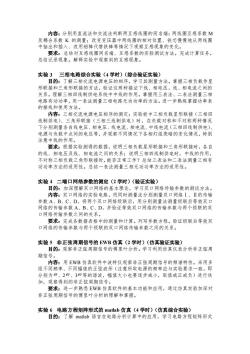
内容:分别用直流法和交流法判断两互感线圈的同名端;两线圈互感系数M 及耦合系数K的测量;改变变压器中两线圈的相对位置、铁芯慢慢地从两线圈 中抽出和插入 改用铝棒代替铁棒等情况下观察互感现象的变化。 要求: 总结对互感线圈同名端、互感系数的实验测试方法。完成计算任务, 总结记录现象。解释实验中观察到的互感现象。 实验3三相电路综合实验(4学时)(综合验证实验) 目的:了解三相交流电源电压的相序,学习其测量方法。掌握三相负载作星 形联接和三角形联接的方法,验证这两种接法下线、相电压,线、相电流之间的 关系。理解三相四线制供电系统中中线的作用。掌握用三表法、二表法测量三相 电路有功功率 用 表法测量三相电路无功功率的方法。进一步熟练掌握功率表 的接线和使用方法 内容:三相交流电源电压相序的测定;实验板中三相负载星形联接(三相四 线制供电)、三角形联接(三相三线制供电)时,在负载对称和不对称两种情况 下分别测量冬自线申压、相申压线申流相申洁、中线申流(三相四缘制供由) 生囊与乡龙步回而电压等并观察不可指说下各相灯 组亮暗的变化情况,特别 线的 9 要求:根据实验测得的数据,说明三相负载星形联接和三角形联接时,各自 的线、相电压及线、相电流之间的关系;说明三相四线制供电时,中线的作用, 不对称三相负载三角形联接时,能否正常工作?总结三表法和二表法测量三相有 功功率方法的适用性。总结一表法测量三相无功功率方法的适用性 实验4二端口网络参数的测定(2学时)(验证实验) 目的:加深理解双口网络的基本理 双口网络传输参数的测试方法 内容:双口网络的实验电路,用同时测量法分别测量双口网络I、Ⅱ的传输 参数A、B、C、D,将两个双口网络级联后,用分别测量法测量级联后等效双口 网络的传输参数A、B、C、D,并验证等效双口网络的传输参数与两个级联的双 口网络传输参数之间的关系。 要求:完成各数据表格中的测量和计算。列写参数方 。验证级联后等效双 口网络的传输参数与两个级联的双口网络传输参数之间的关系。 实验5非正弦周期信号的EWB仿真(2学时)(仿真验证实验) 目的:观察非正弦周期信号的傅里叶分析。学习利用仿真仪表分析非正弦周 期信 内容:用WB仿真软件中波特仪观察非正弦周期信号的频谱特性。采用多 组不同频率 不同幅 的正弦波形(注意所取电源的频率应 与实验要求 分别为0、20 3”等的谐波,幅值大小也要逐步减小,取值或正或负)进行选 加,观察得到的非正弦周期信号。 要求:进一步熟悉EWB仿真软件的基本功能和应用,通过仿真实验加深对 非正弦周期信号的傅里叶分析的理解和掌握。 实验6电略方程矩阵形式的matlab仿真(4学时)(仿真综合实验) 目的:了解matlab语言在电路分析计算中的应用,学习电路方程矩阵形式
内容:分别用直流法和交流法判断两互感线圈的同名端;两线圈互感系数 M 及耦合系数 K 的测量;改变变压器中两线圈的相对位置、铁芯慢慢地从两线圈 中抽出和插入、改用铝棒代替铁棒等情况下观察互感现象的变化。 要求:总结对互感线圈同名端、互感系数的实验测试方法。完成计算任务, 总结记录现象。解释实验中观察到的互感现象。 实验 3 三相电路综合实验(4 学时)(综合验证实验) 目的:了解三相交流电源电压的相序,学习其测量方法。掌握三相负载作星 形联接和三角形联接的方法,验证这两种接法下线、相电压,线、相电流之间的 关系。理解三相四线制供电系统中中线的作用。掌握用三表法、二表法测量三相 电路有功功率,用一表法测量三相电路无功功率的方法。进一步熟练掌握功率表 的接线和使用方法。 内容:三相交流电源电压相序的测定;实验板中三相负载星形联接(三相四 线制供电)、三角形联接(三相三线制供电)时,在负载对称和不对称两种情况 下分别测量各自线电压、相电压、线电流、相电流、中线电流(三相四线制供电)、 电源与负载中点间的电压等,并观察不同情况下各相灯组亮暗的变化情况,特别 注意中线的作用。 要求:根据实验测得的数据,说明三相负载星形联接和三角形联接时,各自 的线、相电压及线、相电流之间的关系;说明三相四线制供电时,中线的作用, 不对称三相负载三角形联接时,能否正常工作?总结三表法和二表法测量三相有 功功率方法的适用性。总结一表法测量三相无功功率方法的适用性。 实验 4 二端口网络参数的测定(2 学时)(验证实验) 目的:加深理解双口网络的基本理论,学习双口网络传输参数的测试方法。 内容:双口网络的实验电路,用同时测量法分别测量双口网络Ⅰ、Ⅱ的传输 参数 A、B、C、D,将两个双口网络级联后,用分别测量法测量级联后等效双口 网络的传输参数 A、B、C、D,并验证等效双口网络的传输参数与两个级联的双 口网络传输参数之间的关系。 要求:完成各数据表格中的测量和计算。列写参数方程。验证级联后等效双 口网络的传输参数与两个级联的双口网络传输参数之间的关系。 实验 5 非正弦周期信号的 EWB 仿真(2 学时)(仿真验证实验) 目的:观察非正弦周期信号的傅里叶分析。学习利用仿真仪表分析非正弦周 期信号。 内容:用 EWB 仿真软件中波特仪观察非正弦周期信号的频谱特性。采用多 组不同频率、不同幅值的正弦波形(注意所取电源的频率应与实验要求一致,即 分别为 、2 、3 等的谐波,幅值大小也要逐步减小,取值或正或负)进行迭 加,观察得到的非正弦周期信号。 要求:进一步熟悉 EWB 仿真软件的基本功能和应用,通过仿真实验加深对 非正弦周期信号的傅里叶分析的理解和掌握。 实验 6 电路方程矩阵形式的 matlab 仿真(4 学时)(仿真综合实验) 目的:了解 matlab 语言在电路分析计算中的应用,学习电路方程矩阵形式
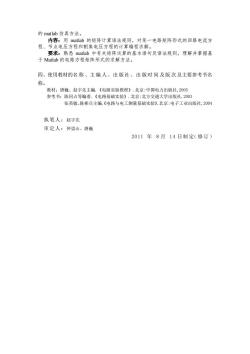
的matlab仿真方法。 程、 内容:用 1 atlab的矩阵计算语法规则,对某一电路矩阵形式的回路电流方 计算编程求解 要求:熟悉matlab中有关矩阵运算的基本语句及语法规则,理解并掌握基 于Matlab的电路方程矩阵形式的求解方法。 四、使用教材的名称、主编人、出版社、出版时间及版次及主要参考书名 称。 教材:唐巍、赵字先主编.《电路实验教程》.北京:中国电力出版社,2005 参考书:陈同占等编者.《电路基础实验》,北京:北方交通大学出版社,2003 张英敏、陈彬兵主编.《电路与电工测量基础实验》.北京:电子工业出版社,2004 执笔人:赵字先 审定人:仲崇山、唐巍 2011年8月14日制定(修订)
的 matlab 仿真方法。 内容:用 matlab 的矩阵计算语法规则,对某一电路矩阵形式的回路电流方 程、节点电压方程和割集电压方程的计算编程求解。 要求:熟悉 matlab 中有关矩阵运算的基本语句及语法规则,理解并掌握基 于 Matlab 的电路方程矩阵形式的求解方法。 四、使用教材的名 称 、主 编 人、出 版社 、出 版时 间 及版 次及主要参考书名 称。 教材:唐巍、赵宇先主编.《电路实验教程》.北京:中国电力出版社,2005 参考书:陈同占等编着.《电路基础实验》.北京:北方交通大学出版社,2003 张英敏、陈彬兵主编.《电路与电工测量基础实验》.北京:电子工业出版社,2004 执笔人:赵宇先 审定人:仲崇山、唐巍 20 11 年 8 月 1 4 日制 定( 修 订)
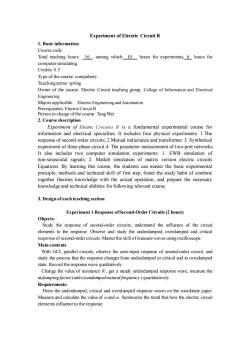
Experiment of Electric Circuit B 1.Basic information Course code Total teaching hours:16,among which 10 hours for experiments,6 hours for computer simulating Credits:0.5 Type of the cours mpulsory Teaching terms:spring Owner of the course:Electric Circuit teaching group,College of Information and Electrical Engineering Majors applicable:Electric Engineering and Automation Prerequisites:Electric Circuit B Person in charge of the course:Tang Wei 2.Course description Experiment of Electric Circuits B is a fundamental experimental course for information specialties.four physical exp riments:1.The response of se ond-o ,2.Mutual inductance and transformer.Synthetical experiment of three-phase circuit.4.The parameter measurement of two-port networks It also includes two computer simulation experiments:1.EWB simulation of non-sinusoidal signals;2.Matlab simulation of matrix version electric circuits Equations.By learning this course,the students can master the basic experimental and tehnical skill of first step foster the study habit of combin together theories knowledge with the actual operation,and prepare the necessary knowledge and technical abilities for following relevant course. 3.Design ofeach teaching section Experiment 1 Response ofSecond-Order Circuits(2 hours) Objects: Study the response of second-order circuits,understand the influence of the circuit elements to the response.Observe and study the underdamped,overdamped and critical response of second-order circuits.Master the skill of measure waves usingoscilloscope. Main contents With GCL parallel circuits,observe the zero-input respons of circuit,and study the process that the response changes from underdamped to critical and to overdamped state.Record the response wave qualitatively. Change the value of resistance R.get a steady underdamped response wave.measure the a(damping factor)and o(undampednanral frequency)quantitativel Requirements Draw the underdamped,critical and overdamped response waves on the coordinate paper Measure and calculate the value of a and Summarize the trend that how the electric circuit elements influence to the response
Experiment of Electric Circuit B 1. Basic information Course code: Total teaching hours: 16 , among which 10 hours for experiments, 6 hours for computersimulating. Credits: 0.5 Type of the course: compulsory Teaching terms: spring Owner of the course: Electric Circuit teaching group, College of Information and Electrical Engineering Majors applicable: Electric Engineering and Automation Prerequisites: Electric Circuit B Person in charge of the course: Tang Wei 2. Course description Experiment of Electric Ci rc uit s B is a fundamental experimental course for information and electrical specialties. It includes four physical experiments: 1.The response of second-order circuits; 2.Mutual inductance and transformer. 3. Synthetical experiment of three-phase circuit.4. The parameter measurement of two-port networks. It also includes two computer simulation experiments: 1. EWB simulation of non-sinusoidal signals; 2. Matlab simulation of matrix version electric circuits Equations. By learning this course, the students can master the basic experimental principle, methods and technical skill of first step, foster the study habit of combine together theories knowledge with the actual operation, and prepare the necessary knowledge and technical abilities for following relevant course. 3. Design of each teaching section Experiment 1 Response of Second-Order Circuits (2 hours) Objects: Study the response of second-order circuits, understand the influence of the circuit elements to the response. Observe and study the underdamped, overdamped and critical response of second-order circuits. Master the skill of measure waves using oscilloscope. Main contents With GCL parallel circuits, observe the zero-input response of second-order circuit, and study the process that the response changes from underdamped to critical and to overdamped state. Record the response wave qualitatively. Change the value of resistance R , get a steady underdamped response wave, measure the α(damping factor) and ω(undamped natural frequency ) quantitatively. Requirements: Draw the underdamped, critical and overdamped response waves on the coordinate paper. Measure and calculate the value of α and ω. Summarize the trend that how the electric circuit elements influence to the response
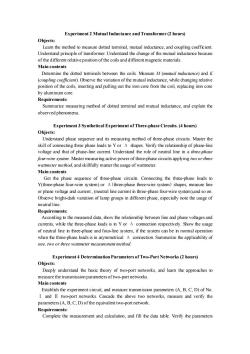
Experiment 2 Mutual Inductance and Transformer(2 hours) Objects Leam the method o measure dotted teminal,mutal inductance,and couping Understand principle of transformer.Understand the change of the mutual inductance because of the different relative position of the coils and different magnetic materials. Main contents Detemine the dotted temminals between the cois Measure M(mal indcance)and K (copling).Observe the variation of the mutual inductance,while changing relative position of the coils.inserting and pulling out the iron core from the coil,replacing iron core by aluminum core Requirements: Summarize measuring method of dotted teminal and mutal inductance,and explain the Experiment 3 Synthetical Experiment of Three-phase Circuits.(4 hours) Objects: Understand phase sequence and its measuring method of three-phase circuits.Master the or A olegeandh phase loads to Y ip of phase -lin at of phase-line current.Understand the role of neutral line in four-wire system.Master measuring active power of three-phase circuits applying oor three wattmeter method,and skillfully master the usage of wattmeter. Main contents Get the phase sec uence of three phase circuits.Connecting the three-phase Y仙 or phase voltage and current,(neutral line current in three-phase four-wire system)and so on Observe bright-dark variation of lamp groups in different phase,especially note the usage of neutral line. Requirements Accordingto the measured between ine and and currents.while the three-phase loads is in Yor connection respectively.Show the usage of neutral line in three-phase and four-line system,if the system can be in nomal operation when the three-phase loads is in asymmetrical A connection.Summarize the applicability of one,wo or three watmeter measurement method. Experiment 4 Determination Parameters of Two-Port Networks(2 hours) Objects: Deeply understand the basic theory of two-port networks,and leam the approaches to measure the transmission parameters of two-port networks. Main contents Esta lish the experimentc and mea ure transmission parameters(A,B.C.D)of No I and II two-port networks Cascade the above two networks,measure and verify the parameters(A.B.C.D)ofthe equivalent two-port network. Requirements: Complete the measurement and calculation,and fill the data table.Verify the parameters
Experiment 2 Mutual Inductance and Transformer (2 hours) Objects: Learn the method to measure dotted terminal, mutual inductance, and coupling coefficient. Understand principle of transformer. Understand the change of the mutual inductance because of the different relative position of the coils and different magnetic materials. Main contents Determine the dotted terminals between the coils. Measure M (mutual inductance) and K (coupling coefficient). Observe the variation of the mutual inductance, while changing relative position of the coils, inserting and pulling out the iron core from the coil, replacing iron core by aluminum core. Requirements: Summarize measuring method of dotted terminal and mutual inductance, and explain the observed phenomena. Experiment 3 Synthetical Experiment of Three-phase Circuits. (4 hours) Objects: Understand phase sequence and its measuring method of three-phase circuits. Master the skill of connecting three phase loads to Y or Δ shapes. Verify the relationship of phase-line voltage and that of phase-line current. Understand the role of neutral line in a three-phase four-wire system. Master measuring active power of three-phase circuits applying two or three wattmeter method, and skillfully master the usage of wattmeter. Main contents Get the phase sequence of three-phase circuits. Connecting the three-phase loads to Y(three-phase four-wire system) or Δ(three-phase three-wire system) shapes, measure line or phase voltage and current , (neutral line current in three-phase four-wire system),and so on. Observe bright-dark variation of lamp groups in different phase, especially note the usage of neutral line. Requirements: According to the measured data, show the relationship between line and phase voltages and currents, while the three-phase loads is in Y or Δ connection respectively. Show the usage of neutral line in three-phase and four-line system, if the system can be in normal operation when the three-phase loads is in asymmetrical Δ connection. Summarize the applicability of one, two or three wattmeter measurement method. Experiment 4 Determination Parameters of Two-Port Networks (2 hours) Objects: Deeply understand the basic theory of two-port networks, and learn the approaches to measure the transmission parameters of two-port networks. Main contents Establish the experiment circuit, and measure transmission parameters (A, B, C, D) of No. Ⅰ and Ⅱ two-port networks. Cascade the above two networks, measure and verify the parameters(A, B, C, D) of the equivalent two-port network. Requirements: Complete the measurement and calculation, and fill the data table. Verify the parameters
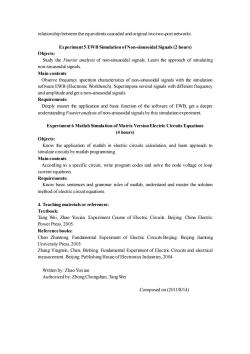
relationship between the equivalents cascaded and original two two-port networks. Experiment 5 EWB Simulation of Non-sinusoidal Signals(2 hours) Objects: Study the Fourier analysis of non-sinusoidal signals.Learn the approach of simulating non-sinusoidal signals. Observe frequency pectrum characteristics of non-sinusoidal signals software EWB(Electronic Workbench).Superimpose several signals with different frequency and amplitude and get a non-sinusoidal signals. Requirements: Deeply master the application and basic function of the software of EWB,get a deeper understandingFofo-sinusoidal signals by this Experiment 6 Matlab Simulation of Matrix Version Electric Circuits Equations (4 hours) Objects: m According to a specific circuit,write program codes and solve the node voltage or loop current equations Requirements Know basic s s and grammar rules of matlab,understand and master the solutior method ofelectric circuit equations 4.Teaching materials or references: Textbook: Tang Wei,Zhao Yuxian.Experiment Course of Electric Circuits.Beijing:China Electric PowerPress.2005 Reference books: Chen Zhantong Fundamental Experiment of Electric Circuits.Beijing:Beijing Jiaotong University Press.2003 Zhang Yingmin,Chen,Binbing.Fundamental Experiment of Electric Circuits and electrical measuremen Beijing:Publishing Houseof Electronics Industries,2004 Written by:Zhao Yuxian Authorized by:Zhong Chongshan,Tang Wei Composed on(2011/8/14)
relationship between the equivalents cascaded and original two two-port networks. Experiment 5 EWB Simulation of Non-sinusoidal Signals (2 hours) Objects: Study the Fourier analysis of non-sinusoidal signals. Learn the approach of simulating non-sinusoidal signals. Main contents Observe frequency spectrum characteristics of non-sinusoidal signals with the simulation software EWB (Electronic Workbench). Superimpose several signals with different frequency and amplitude and get a non-sinusoidal signals. Requirements: Deeply master the application and basic function of the software of EWB, get a deeper understanding Fourier analysis of non-sinusoidal signals by this simulation experiment. Experiment 6 Matlab Simulation of Matrix Version Electric Circuits Equations (4 hours) Objects: Know the application of matlab in electric circuits calculation, and learn approach to simulate circuits by matlab programming. Main contents According to a specific circuit, write program codes and solve the node voltage or loop current equations. Requirements: Know basic sentences and grammar rules of matlab, understand and master the solution method of electric circuit equations. 4. Teaching materials or references: Textbook: Tang Wei, Zhao Yuxian. Experiment Course of Electric Circuits. Beijing: China Electric Power Press, 2005. Reference books: Chen Zhantong. Fundamental Experiment of Electric Circuits.Beijing: Beijing Jiaotong University Press, 2003 Zhang Yingmin, Chen, Binbing. Fundamental Experiment of Electric Circuits and electrical measurement. Beijing: Publishing House of Electronics Industries, 2004 Written by: Zhao Yuxian Authorized by: Zhong Chongshan, Tang Wei Composed on (2011/8/14)
按次数下载不扣除下载券;
注册用户24小时内重复下载只扣除一次;
顺序:VIP每日次数-->可用次数-->下载券;
- 《电路》课程实验教学大纲 Experiment of Electric Circuit A.doc
- 《电路》课程教学大纲 Electric Circuit B.doc
- 《电路》课程教学大纲 Electric Circuit A.doc
- 《单片机原理与应用》课程教学课件(PPT讲稿)第3章 8051指令系统与编程基础.ppt
- 《单片机原理与应用》课程教学课件(PPT讲稿)第2章 AT89S51单片机硬件结构(1/2).ppt
- 《单片机原理与应用》课程教学课件(PPT讲稿)第2章 AT89S51单片机硬件结构(2/2).ppt
- 《单片机原理与应用》课程教学课件(PPT讲稿)第4章 AT89S52单片机的中断系统(1/2).ppt
- 《单片机原理与应用》课程教学课件(PPT讲稿)第5章 AT89S52单片机的定时器计数器(1/2).ppt
- 《单片机原理与应用》课程教学课件(PPT讲稿)第4章 AT89S52单片机的中断系统(2/2).ppt
- 《单片机原理与应用》课程教学课件(PPT讲稿)第5章 AT89S52单片机的定时器计数器(2/2).ppt
- 《单片机原理与应用》课程教学课件(PPT讲稿)第6章 AT89S52单片机的串行口(1/2).ppt
- 《单片机原理与应用》课程教学课件(PPT讲稿)第6章 AT89S52单片机的串行口(2/2).ppt
- 《单片机原理与应用》课程教学课件(PPT讲稿)ADDA电机(AT89S51单片机与DAC的接口).pptx
- 《单片机原理与应用》课程教学课件(PPT讲稿)DS18B20总线扩展技术.pptx
- 《单片机原理与应用》课程教学资源(学习资料)DS18B20测温头文件使用方法.docx
- 《单片机原理与应用》课程教学资源(授课教案)单片机定时/计数器模块.doc
- 《单片机原理与应用》课程教学资源(授课教案)AT89S52单片机的硬件组成、单片机的引脚功能(一).docx
- 《单片机原理与应用》课程教学资源(授课教案)3.7 8051汇编语言程序设计基础、3.8 汇编语言程序设计举例Keilc程序设计.docx
- 《单片机原理与应用》课程教学资源(授课教案)3.4 8051指令系统分类介绍、C语言中相关编程结构.docx
- 《单片机原理与应用》课程教学资源(授课教案)3.1 指令系统概述 3.2 指令格式 3.3 指令寻址方式 3.4 指令分类.docx
- 《电路》课程教学资源(实验指导)实验1 元件伏安特性.doc
- 《电路》课程教学资源(实验指导)实验5 RLC元件阻抗特性及交流等效参数的测定.doc
- 《电路》课程教学资源(实验指导)实验3 直流电路基本定理综合实验.doc
- 《电路》课程教学资源(实验指导)实验2 电源等效变换戴维南定理.doc
- 《电路》课程教学资源(实验指导)实验4 电路过渡过程的研究.doc
- 《电路》课程教学资源(实验指导)实验7 RLC串联谐振电路的研究.doc
- 《电路》课程教学资源(实验指导)实验6 日光灯电路及功率因数的提高.doc
- 《电路》课程教学资源(实验指导)实验8 RC选频网络特性的测试.doc
- 《电路》课程教学资源(实验指导)实验9 单相电度表的校验.doc
- 《电路》课程教学资源(实验指导)实验11 三相电路综合实验.doc
- 《电路》课程教学资源(实验指导)实验13 电阻温度计的制作.doc
- 《电路》课程教学资源(实验指导)实验12 二端口网络参数的测定.doc
- 《电路》课程教学资源(实验指导)实验14 运算放大器的应用.doc
- 《电路》课程教学资源(实验指导)实验10 互感与变压器.doc
- 《电路》课程教学资源(实验指导)实验15 移相器的设计与测试.doc
- 《电路》课程教学资源(实验指导)实验16 负阻抗变换器的制作和应用.doc
- 《电路》课程教学资源(实验指导)实验17 RC一阶电路动态特性的仿真.doc
- 《电路》课程教学资源(实验指导)实验18 RLC串联谐振电路的仿真.doc
- 《电路》课程教学资源(实验指导)实验19 非正弦周期信号电路的仿真.doc
- 《电路》课程教学资源(实验指导)实验20 电路矩阵方程的计算机求解.doc
